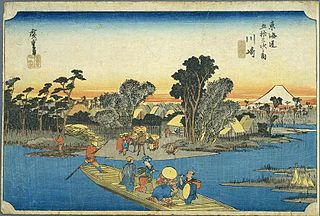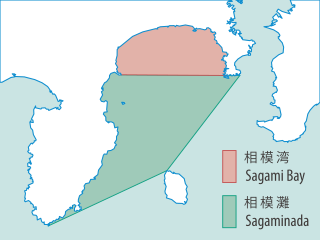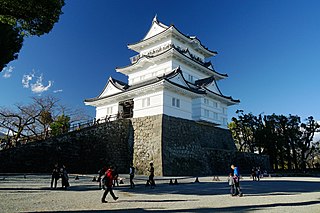
Hiratsuka is a city located in Kanagawa Prefecture, Japan.

Sagami Province was a province of Japan located in what is today the central and western Kanagawa Prefecture. Sagami bordered on Izu, Musashi, Suruga Provinces; and had access to the Pacific Ocean through Sagami Bay. However, most of the present-day cities of Yokohama and Kawasaki, now part of Kanagawa Prefecture, were not in Sagami, but rather, in Musashi Province. Its abbreviated form name was Sōshū (相州).

Minamiashigara is a city located in Kanagawa Prefecture, Japan.

Odawara Station is a railway station in Odawara, Kanagawa, Japan. It is a gateway station to the Hakone area.

Ōiso is a town located in Kanagawa Prefecture, Japan. As of June 2012, the town had an estimated population of 32,786, and a density of 1,910 people per km2. The total area is 17.18 km2.

Hakone is a town in Kanagawa Prefecture, Japan. As of June 2012, the town had an estimated population of 13,492, and a population density of 145 persons per km². The total area is 92.82 km². Hakone has been designated as a Japanese National Geopark by the Japanese Geoparks Network.

Hodogaya-ku (保土ケ谷区) is one of the 18 wards of the city of Yokohama in Kanagawa Prefecture, Japan. As of 2010, Hodogaya Ward had an estimated population of 205,887 and a density of 9,400 inhabitants per square kilometer (24,000/sq mi). The total area was 21.91 km2 (8.46 sq mi).
Ai no Shuku were unofficial post stations along historical routes in Japan. These post stations formed organically along routes when the distance between two places was too far or when there were difficult passes nearby. Because they were not officially designated rest areas, travelers along the roads were not allowed to stay in these post stations. Sometimes the Japanese is shortened to 間宿.

Mishima-shuku was the eleventh of the fifty-three stations of the Tōkaidō during Edo period Japan. It is located in the present-day city of Mishima, in Shizuoka Prefecture.

Kawasaki-juku was the second of the fifty-three stations of the Tōkaidō. It is located in Kawasaki-ku in the present-day city of Kawasaki, Kanagawa Prefecture, Japan.

Hodogaya-juku was the fourth of the fifty-three stations of the Tōkaidō. It is located in Hodogaya-ku in the present-day city of Yokohama, Kanagawa Prefecture, Japan. Occasionally, it is also written as 保土ヶ谷宿.

Hakone-juku was the tenth of the fifty-three stations of the Tōkaidō. It is located in the present-day town of Hakone in Ashigarashimo District, Kanagawa Prefecture, Japan. At an elevation of 725m, it is the highest post station on the entire Tōkaidō and was even difficult for the bakufu to maintain.

Kuwana-juku was the forty-second of the fifty-three stations of the Tōkaidō. It is located in former Ise Province in what is now part of the city of Kuwana, in Mie Prefecture, Japan. It was located on the western shores of the Ibi River and is considered to be the easternmost point of the Kansai dialect. It is 28 km from the preceding post station of Miya-juku.

Totsuka-juku was the fifth of the fifty-three stations (shukuba) of the Tōkaidō. It was the eastern-most post station in Sagami Province. It is now located in Totsuka-ku in the present-day city of Yokohama, Kanagawa Prefecture, Japan.

Fujisawa-shuku was the sixth of the fifty-three stations of the Tōkaidō. It is located in the present-day city of Fujisawa, Kanagawa Prefecture, Japan.

Ōiso-juku was the eighth of the fifty-three stations (shukuba) of the Tōkaidō. It is located in the present-day town of Ōiso, located in Naka District, Kanagawa Prefecture, Japan.

Shimada-juku was the twenty-third of the fifty-three stations of the Tōkaidō. It is located in what is now part of Shimada, Shizuoka Prefecture, Japan.
Ōkubo Tadaaki was the 6th daimyō of Odawara Domain in Sagami Province in mid-Edo period Japan. His courtesy title was Kaga no Kami.






















